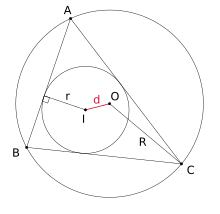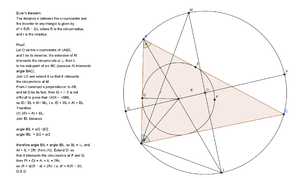Euler's theorem in geometry
In geometry, Euler's theorem states that the distance d between the circumcentre and incentre of a triangle is given by[1][2]

or equivalently
where R and r denote the circumradius and inradius respectively (the radii of the circumscribed circle and inscribed circle respectively). The theorem is named for Leonhard Euler, who published it in 1765.[3] However, the same result was published earlier by William Chapple in 1746.[4]
From the theorem follows the Euler inequality:[5][6]
which holds with equality only in the equilateral case.[7]:p. 198
Proof

Letting O be the circumcentre of triangle ABC, and I be its incentre, the extension of AI intersects the circumcircle at L. Then L is the midpoint of arc BC. Join LO and extend it so that it intersects the circumcircle at M. From I construct a perpendicular to AB, and let D be its foot, so ID = r. It is not difficult to prove that triangle ADI is similar to triangle MBL, so ID / BL = AI / ML, i.e. ID × ML = AI × BL. Therefore 2Rr = AI × BL. Join BI. Because
- ∠ BIL = ∠ A / 2 + ∠ ABC / 2,
- ∠ IBL = ∠ ABC / 2 + ∠ CBL = ∠ ABC / 2 + ∠ A / 2,
we have ∠ BIL = ∠ IBL, so BL = IL, and AI × IL = 2Rr. Extend OI so that it intersects the circumcircle at P and Q; then PI × QI = AI × IL = 2Rr, so (R + d)(R − d) = 2Rr, i.e. d2 = R(R − 2r).
Stronger version of the inequality
A stronger version[7]:p. 198 is
where a, b, c are the sidelengths of the triangle.
Euler's theorem for the escribed circle
If and denote respectively the radius of the escribed circle opposite to the vertex and the distance between its centre and the centre of the circumscribed circle, then .
Euler's inequality in absolute geometry
Euler's inequality, in the form stating that, for all triangles inscribed in a given circle, the maximum of the radius of the inscribed circle is reached for the equilateral triangle and only for it, is valid in absolute geometry.[8]
See also
- Fuss' theorem for the relation among the same three variables in bicentric quadrilaterals
- Poncelet's closure theorem, showing that there is an infinity of triangles with the same two circles (and therefore the same R, r, and d)
- List of triangle inequalities
References
- Johnson, Roger A. (2007) [1929], Advanced Euclidean Geometry, Dover Publ., p. 186.
- Dunham, William (2007), The Genius of Euler: Reflections on his Life and Work, Spectrum Series, 2, Mathematical Association of America, p. 300, ISBN 9780883855584.
- Gerry Leversha, G. C. Smith: Euler and Triangle Geometry. In: The Mathematical Gazette, Vol. 91, No. 522, Nov., 2007, S. 436–452 (JSTOR 40378417)
- Chapple, William (1746), "An essay on the properties of triangles inscribed in and circumscribed about two given circles", Miscellanea Curiosa Mathematica, 4: 117–124. The formula for the distance is near the bottom of p.123.
- Alsina, Claudi; Nelsen, Roger (2009), When Less is More: Visualizing Basic Inequalities, Dolciani Mathematical Expositions, 36, Mathematical Association of America, p. 56, ISBN 9780883853429.
- Debnath, Lokenath (2010), The Legacy of Leonhard Euler: A Tricentennial Tribute, World Scientific, p. 124, ISBN 9781848165250.
- Svrtan, Dragutin; Veljan, Darko (2012), "Non-Euclidean versions of some classical triangle inequalities", Forum Geometricorum, 12: 197–209.
- Pambuccian, Victor; Schacht, Celia (2018), "Euler's inequality in absolute geoemtry", Journal of Geometry, 109 (Art. 8): 1–11, doi:10.1007/s00022-018-0414-6.
External links
| Wikimedia Commons has media related to Euler's theorem in geometry. |